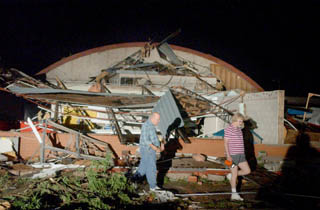Small towns get a bad rap sometimes. The cliche is that they’re boring and backward, lacking culture, diversity, opportunity, and other hallmarks of the modern lifestyle. In my opinion, it’s a grave mistake to write off the rural half of America like this: it seems to me that every small town has its own complicated dynamics and fascinating personalities. I keep finding myself in Seymour, Missouri, a town of around 2000 people in the heart of Amish country. When you’re driving through, all you see are two traffic lights and a few metal-sided buildings for commerce. But if you stop and get acquainted with the locals, ooh boy… in just a few weeks (between 8 and 5 only, mind you), I’ve accumulated a collection of vignettes that barely scratches the surface of the community.
When on the job, Russel and I frequent a machine shop in Seymour to work on various invention and fabrication projects. The guys who work in the shop range from age 18 to over 60, all lifers to that county. All skilled in multiple aspects of metal fabrication (welding, cutting, drilling, milling, sandblasting, painting) that I didn’t know the first thing about on my first visit 6 years ago. The pay is barely above the federal minimum wage, which seems low for the sheer amount of equipment they produce for their hefty military contracts. But it’s stable, good work, and the guys take pride in their craft. Joe and Justin saved up for a year to take a trip to the Dominican Republic. Gerald recently won $100k in the lottery and used it to buy a larger property for his modular home. Justin’s dad Bobby hilariously grumbles about everything, but he’s so helpful he’d give you the shirt off his back. They collectively vent about the lazy new employee. They pick on the high school intern – a good kid and skilled machinist who was preparing for technical college. (Edit: neither of these people work there anymore, for better or worse.) The owner Rick sets the tone, balancing respectful leadership with occasional pranks for levity. Russel regards him and Bobby as family: all in all, they’re unwaveringly supportive of their kin, a theme in rural American culture.
Venturing out, the cast of characters becomes more eclectic. Russel’s two brothers live in town: Mike runs a competing machine shop a stone’s throw away. A foil of Russel, Mike painstakingly designs his equipment builds in multiple CAD programs, then uses one of several CNC machines in his pristine workshop to cut everything to size and weld parts together by the book. A libertarian to the core, he has amassed tools and equipment solely to avoid paying taxes on profits (though, ironically, he has persistently petitioned the city to condemn the beekeeper next door). Russel’s other brother Gabe currently drives a cement mixer and is one of the funniest people I’ve ever met. His house in town belongs in a movie, towering and irregular like a child’s block fort, sided with shiny aluminum sheets, his yard gradually paved over with extra concrete from work. Last fall, he had to pour a slab for a local nudist ranch called Cactus Canyon, a story I have to withhold because the exchange was…prickly.
I mentioned this is Amish country, which adds a very interesting cultural dynamic to Seymour. The Amish live outside of town in a few enclaves, driving their horse-drawn wagons at a quick trot into town. One place we always encounter Amish is the farm supply/hardware store: they are incredibly polite, greeting you briefly with a hint of Germanic accent (at home, they speak a rare Swiss dialect and refer to us as “the English”). The Amish kids will stare at you silently, like children of the corn. Acknowledging a need to diversify the gene pool as their population dwindled, they have matchmaking exchanges with another Swiss Amish enclave in Indiana – consequently, the community has grown substantially since the 60s, according to census data. While I have not had much direct interaction with the Amish, I have heard numerous stories of their shrewd business dealings, heretical extramarital affairs, and incredible toughness in manual labor…fascinating folks.
A couple more profiles: Eric is another Seymour lifer who owns and operates a roadside barbecue stand. That is the only normal thing about him, however, as I found out when I went around back where he used to keep his bears. Yep, black bears that he raised from cubs. The two times we stopped at his stand he showed us incredible videos on his smartphone: this week, a tornado reaching down fingers of condensation viewed from a few hundred yards away. The first time it was an orb of light that hovered in place for several seconds then took off with a sonic boom. Locals were split whether it was a secret military exercise or a UFO, unidentifiable from the typical grainy footage taken at twilight. Brandon, owner of the local offroading ranch and extreme fireworks enthusiast, insisted that the mysterious light was part of an elaborate military/government conspiracy “like how they faked the moon landings.” Of course small towns like Seymour often have their share of hardships and public drama, and gossip is overwhelmingly pervasive and personal. But I have thoroughly enjoyed experiencing Seymour, as an outsider with a front row seat to the town’s Pulitzer-worthy goings-on. I hope to continue to intimately understand the communities where my travels take me, as I am eager to See More America!

